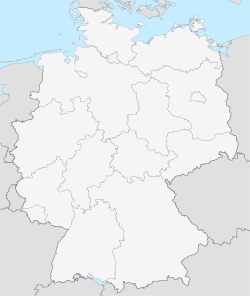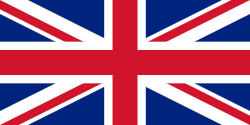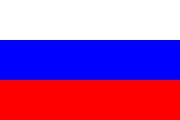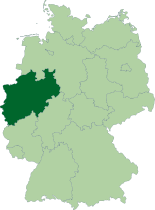Düsseldorf
| Düsseldorf | |
 |
|
| Coat of arms | Location |
 |
 |
| Administration | |
| Country | Germany |
|---|---|
| State | North Rhine-Westphalia |
| Admin. region | Düsseldorf |
| District | Urban district |
| City subdivisions | 10 districts, 49 boroughs |
| Lord Mayor | Dirk Elbers (CDU) |
| Governing parties | CDU / FDP |
| Basic statistics | |
| Area | 217 km² (83.8 sq mi) |
| Elevation | 38 m (125 ft) |
| Population | 581,858 (30/12/2006)[1] |
| - Density | 2,681 /km² (6,945 /sq mi) |
| Other information | |
| Time zone | CET/CEST (UTC+1/+2) |
| Licence plate | D |
| Postal codes | 40001-40629 |
| Area code | 0211 |
| Website | duesseldorf.de |
Düsseldorf (IPA: [ˈdʏsəldɔɐf]) is the capital city of the German state of North Rhine-Westphalia. It is an economic centre of Germany. The city is situated on the River Rhine and has a high population density - the Rhine-Ruhr metropolitan area has over 10 million inhabitants alone. The city is renowned for its many events and also for its fashion and trade fairs. Every July more than 4.5 million people visit the Große Düsseldorfer Kirmes fair.
Contents |
History
When the Roman Empire was strengthening its position throughout Europe, a few Germanic tribes clung on to their marshy territory off the eastern banks of the Rhine River.
In the 7th and 8th centuries, the odd farming or fishing settlement could be found at the point where the small river Düssel flows into the Rhine. It was from such settlements that the city of Düsseldorf grew.
The first written mention of the town of Düsseldorf dates back to 1135 (then called Düsseldorp). It was told that under Emperor Friedrich Barbarossa the small town of Kaiserswerth, lying to the North of Düsseldorf, became a well fortified outpost, where soldiers kept their watchful eyes over every movement on the Rhine. Kaiserswerth eventually became a suburb of Düsseldorf in 1929.

In 1186 Düsseldorf came under the rule of Berg. The counts of Berg moved their seat to the town in 1280. 14 August 1288 is one of the most important dates in the history of Düsseldorf as it was on this day that the sovereign Count Adolf V of Berg granted the village on the banks of the Düssel the Town privileges.
Prior to that announcement, a bloody struggle for power had taken place between the Archbishop of Cologne and the count of Berg, culminating in the Battle of Worringen. The Archbishop of Cologne's forces were wiped out by the forces of the count of Berg who were supported by citizens and boors of Cologne and Düsseldorf, paving the way for Düsseldorf's elevation to city status, which is remembered today with a monument on the Burgplatz. In fact, the custom of turning cartwheels is credited to the children of Düsseldorf because, upon hearing that their city was victorious, they did these "flips" in celebration.
After this battle the relationship of the two cities deteriorated, because they were commercial rivals. It is often said that there is a kind of hostility between the citizens of Cologne and Düsseldorf. Today, it finds its expression mainly in a humorous form (especially during the Rhineland Karneval) and in sports.

A market square sprang up on the banks of the Rhine and the square was protected by city walls in all four directions. In 1380, Düsseldorf was made regional capital of the Duchy of Berg. During the following centuries several famous landmarks were built, including the Collegiate Church of St. Lambertus. In 1609, the ducal line of Jülich-Berg-Cleves died out, and after a virulent struggle over succession, Jülich and Berg fell to the Wittelsbach Counts of Palatinate-Neuburg, who made Düsseldorf their main domicile, even after they inherited the Palatinate, in 1685, becoming now Prince-electors as Electors Palatine.
Düsseldorf's growth was even more impressive under the leadership of Johann Wilhelm II (r. 1690-1716) in the 18th century, also known to his people as Jan Wellem. Greatly influenced by his wife Anna Maria Luisa de' Medici, the art lover designed a vast art gallery with a huge selection of paintings and sculptures that were housed in the Stadtschloss (city castle).
After the death of childless Jan Wellem, the flourishing royal capital fell back to hard times, especially after Elector Karl Theodor inherited Bavaria and moved the electoral court to Munich. With him he took the art collection, which became part of what is now the Alte Pinakothek in Munich. Destruction and poverty struck Düsseldorf after the Napoleonic Wars. Napoleon made Berg a Grand Duchy and Düsseldorf its capital. J. C. C. Devaranne, a leader of Solingen's resistance to Napoleon's conscription decrees, was executed here in 1813. After the defeat of Napoleon, the whole Rhineland including Berg was given to the Kingdom of Prussia in 1815. The parliament of the Rhine Province was established in Düsseldorf later.
By the mid-19th century, Düsseldorf enjoyed a revival thanks to the Industrial Revolution as the city boasted 100,000 inhabitants by 1882; the figure doubled in 1892. However, the First and Second World Wars soon plunged Düsseldorf into depression. During World War II, the city was virtually reduced to a pile of rubble as round-the-clock air attacks took their toll.
In 1946 Düsseldorf was made capital of the new federal state of North Rhine-Westphalia. The city's reconstruction proceeded at a frantic pace and the economic transformation saw Düsseldorf growing into the wealthy city of trade, administration and service industries as it is known today.
Geography
Physical geography
Düsseldorf lies in the middle of the lower Rhine basin on the delta of the Düssel River where it flows into the Rhine. The city is on the east side of the Rhine, except for District 4 (Oberkassel, Niederkassel, Heerdt and Lörick).
Across the Rhine Neuss was built on the delta of the Erft river. Düsseldorf lies southwest of the Ruhr mining district, and in the middle of the Rhine-Ruhr urbanized region. Düsseldorf is built entirely on alluvium, muds, sands, clays and occasionally gravels. The highest point in Düsseldorf is the top of Sandberg in the far eastern part of the city (Hubbelrath borough) at 165 metres (541 ft). The lowest point is at the far northern end in Wittlaer borough where the Schwarzbach (Black Creek) enters the Rhine, with an average elevation of 28 metres (92 ft). Like the rest of the lower Rhinelands Düsseldorf has mild winters and moderately warm summers, with an average yearly temperature of 10.5 °C (51 °F) and 77 centimetres (30 in) of rainfall. The predominate wind direction is out of the south or southeast with velocities in the range of 3 to 4 m/s (7-9 mph), with gusts of 3.5 -4.8 m/s (8-10.7 mph). The wind is calm (under 2 m/s or 4.5 mph) about 35% of the time, more frequently at night and in the winter. [2][3]
Districts

Düsseldorf is currently (2007) divided into ten administrative districts. Each district (Bezirk) has its own elected district council (Bezirksvertretung) and its own district mayor (Bezirksvorsteher). The district councils are advisory only. Each district is further subdivided into boroughs. There are 49 boroughs in Düsseldorf[4].
|
|
Adjacent cities and districts
The following districts and cities border Düsseldorf (clockwise starting from the north): the City of Duisburg, the District of Mettmann (Ratingen, Mettmann, Erkrath, Hilden, Langenfeld, and Monheim), and the District of Neuss (Dormagen, Neuss, and Meerbusch).
Economy


Düsseldorf is not only widely known as a centre of the German advertising and fashion industries: in the last few years the city on the Rhine has become one of the top telecommunications centres in Germany. There are 18 internet providers located in the capital of North-Rhine Westphalia. With two of the four big German providers of mobile frequencies, D2 Vodafone and E-Plus, Düsseldorf leads the German mobile phone market. There are also many foreign trading centres in Düsseldorf such as NTT, Ericsson, Sandvik, Nokia and GTS.
Many of the internet companies in Düsseldorf have their roots in the world of advertising: there are 400 advertising agencies in Düsseldorf, among them three of the largest in Germany: BBDO Group, Publicis Group and Grey Group. A number of affiliates of foreign agencies deserve mention as well, such as Ogilvy & Mather, Dentsu, Hakuhodu, Digital District and DDB.
In Düsseldorf there are about 170 national and international financial institutions and about 130 insurance agencies and one of the biggest German stock exchanges. There are also about 200 publishing houses in Düsseldorf.
Several other major companies have their headquarters in the city: L'Oréal Germany (Cosmetics and Beauty); Henkel KGaA (Branded Consumer Goods and Industrial technologies); E.ON (energy); ThyssenKrupp (metallurgy); Metro (wholesale, retail); Ergo (insurance); LTU (air transport), Cognis (chemicals, headquarter in Monheim near Düsseldorf, but production mainly in Düsseldorf).
Daimler builds the transporter Mercedes-Benz Sprinter in Düsseldorf.
Since the 1960s, there has been a strong relationship between the city and Japan. Many Japanese banks and corporations have their European headquarters in Düsseldorf - so many that Düsseldorf has the third largest Japanese community in Europe, after London and Paris. [5] [6]
The "Kö", which stands for Königsallee (King's Avenue) is a popular shopping destination. Some of the most reputed jewellery shops, designer labels, and galleries have their stores here. The Kö has about the highest rents for shops and bureaus in Germany. [7]
Media
Important newspapers and journals such as Handelsblatt, Rheinische Post, Wirtschaftswoche, Deutsches Wirtschaftsblatt and VDI-Nachrichten are published in the city on the Rhine. Almost all of these papers are available online on the Internet. Renowned filmmaking companies, such as Germany's biggest cinema enterprise, the Riech-Group, and TV channels such as WDR, ZDF, CNN, NBC Giga and QVC solidify Düsseldorf's position as a media centre.
Transport

Düsseldorf International Airport, also referred to as Rhein-Ruhr Airport, is located eight kilometres (5 mi) from the city centre and can easily be reached by train or the S-Bahn urban railway. There is a long-distance train station served by regional and national services, which is linked to the airport by the SkyTrain, an automatic peoplemover. The (old) local station situated under the terminal building carries the S-Bahn line (S7) to the city's central station and to Solingen as well as a few selected night services.
After Frankfurt and Munich, Düsseldorf International Airport is Germany's third largest commercial airport, with 16.6 million passengers annually. The airport offers 180 destinations on 4 continents, and is served by 70 airlines. The airport buildings were partly destroyed by a devastating fire caused by welding works in 1996, killing 17 people. It was completely rebuilt and the Skytrain installed.
The city is a major hub in the Deutsche Bahn (DB) railway network. More than 1,000 trains stop in Düsseldorf every day. The central railway station at Konrad-Adenauer-Platz is located in Düsseldorf's city centre. Several S-Bahn lines connect Düsseldorf to the other cities of Rhine-Ruhr. Local light rail Stadtbahn traffic as well as bus traffic is carried out by the city-owned Rheinbahn which operates within the VRR public transport system. The light rail system also serves neighbouring cities and is partially operated underground.
The Central Station (Düsseldorf Hauptbahnhof) and the Airport Station (Flughafen-Bahnhof) are connected to the national and European high speed (Intercity / Eurocity, IC / EC) and extreme high speed InterCityExpress.
North Rhine-Westphalia has a closely-woven autobahn network with many routes leading directly to Düsseldorf. The city is connected to the A3, A44, A46, A52, A57, A59 and A524 motorways.
Facts and figures
Demographics
- 17% of Düsseldorf's population are foreigners, which is a total of 98,686 people. The largest minority ethnic groups are Turkish, Greek, and Italian. [8]
- Düsseldorf has the third largest Jewish community in Germany, with about 7,400 members, which is more than 1% of the city's population.
- Düsseldorf and its surroundings has the third largest Japanese community in Europe and the largest in Germany (about 11,000). [5] [6]
Living in Düsseldorf
The 2007 Mercer HR Consulting survey ranks Düsseldorf on place 5 of the cities with highest quality of life worldwide and number 1 in Germany [9]. This comes at a price; in the same study the cost of living was measured, making Düsseldorf the third most expensive city in Germany after Munich and Frankfurt but equal to Berlin (45th world-wide)[10].
Culture and recreation
Art-loving Elector Jan Wellem and his wife Anna Maria Luisa de' Medici of Tuscany, were the patrons of Düsseldorf's first significant cultural activities in the 17th and 18th centuries. Heinrich Heine, whose 200th birthday was celebrated in 1997, Clara and Robert Schumann as well as Felix Mendelssohn are the most prominent artists related to the city. Artistic impulses were often born in the Academy of Fine Arts and the names of Paul Klee, Joseph Beuys, Gerhard Richter as well as Albert Bierstadt are associated with the institution (Düsseldorf School). The Düsseldorf cultural scene comprises traditional and avant-garde, classical and glamorous. The world famous state art collection of North Rhine-Westphalia, the highly acclaimed Deutsche Oper am Rhein (opera), and the Düsseldorfer Schauspielhaus (theatre), artistic home of Gustaf Gründgens, are major elements of Düsseldorf's reputation as a centre of the fine arts.
Music and nightlife
Since the 1950s the "Kom(m)ödchen" has been one of the most prominent political cabarets of Germany. Düsseldorf's most famous contribution to the culture of modern popular music is beyond doubt the avant-garde electronic music band Kraftwerk. Formed by a few Düsseldorf-born musicians, Kraftwerk have often been regarded as the most significant band in the history of post-war German music and as pioneers in electronic music. Internationally-known power metal band Warlock was formed in Düsseldorf in 1982. Their frontwoman, Doro Pesch, has had a successful solo career in Europe and Asia since Warlock ended. The punk band Die Toten Hosen, which is famous around the world, also the most popular singers in Germany Westernhagen and Heino come from Düsseldorf. The influential electronic act D.A.F. was formed in the city in 1978, as well as the electronic/industrial pioneers Die Krupps in 1980. In The Oldtown (Altstadt) German and international tourists go out on the main street Bolkerstraße, while the local scene (students and creative people) prefers the bars on Ratinger Straße.
Sports

Düsseldorf is also famous for its traditional football team, Fortuna Düsseldorf, the German Champion of 1933. Today, Fortuna competes in the 3. Liga and their new stadium, the LTU arena opened in January 2005 and has a capacity of 51,500. Düsseldorf is one of nine 1974 FIFA World Cup cities and the Rochusclub Düsseldorf hosted the tennis world team cup since 1978.
Other sports in Düsseldorf are ice hockey (the DEG Metro Stars, former DEG - Düsseldorfer Eislauf Gemeinschaft, which play in the new ISS-Dome) and American football. The Düsseldorf Panther are the most successful team in Germany with six national champion trophies and the Eurobowl 1995. In addition the Junior-Programm is the most successful youth-football program in Germany with thirteen national championship titles. Rhine Fire Düsseldorf was an established team of the NFL Europe and won the World Bowl two times in 1998 and 2000. Table tennis is also played (Borussia Düsseldorf), as are handball (HSG Düsseldorf), basketball (Düsseldorf Magics), baseball (Düsseldorf Senators) and dancing (Rot-Weiß Düsseldorf).
Carnival
One of the biggest cultural events in Düsseldorf is the Düsseldorfer Karneval (also referred to as the "fifth season") which starts every year on 11 November at 11:11 a.m., and reaches its climax on Rosenmontag (Rose Monday), featuring a huge parade through the streets of Düsseldorf. Karneval ends on Aschermittwoch (Ash Wednesday). The Düsseldorf carnival is part of the traditional carnival festivities in the Rhineland.
Special drinks and meals
Düsseldorf is well-known for its Altbier, a dark beer, which is brewed only in the region of Düsseldorf. [11] Other traditional drinks are the liqueurs Killepitsch and Samtkragen.
Traditional meals in the region are Rheinischer Sauerbraten (horsemeat or beef pickled for a few days) and Sky and Earth (Himmel on Ähd) (black pudding with stewed apples mixed with mashed potatoes). In winter the people like to eat Muscheln Rheinischer Art (Rhenish-style mussels). Also a special meal: Düsseldorfer Senfrostbraten (Steaks roasted with mustard).
Together with the French city of Dijon Düsseldorf is famous for its Mustard served in a traditional pot called "Mostertpöttche", which was even eternalized in a still life by Vincent van Gogh in 1884. [12]
Theaters

- Deutsche Oper am Rhein (Opera; Ballet)
- Düsseldorfer Schauspielhaus; the theater started with theatralic performances in 1585
- FFT - Forum Freies Theater (Juta and Kammerspiele)
- Kom(m)ödchen (political cabaret)
- Komödie Düsseldorf
- Tonhalle Düsseldorf (classical music, jazz, pop, cabaret)
- Theater an der Kö
- Capitol (musicals)
- Apollo (varieté, circus; shows do not require knowledge of German language)
Museums and arts institutes

- Aquazoo-Löbbecke-Museum (aquarium and zoological museum)
- Forum NRW
- Goethe-Museum
- Heinrich-Heine-Institut
- Kunsthalle Düsseldorf
- Kunstsammlung Nordrhein-Westfalen - K20 (Grabbeplatz) and K21 (Ständehaus)
- Kunstverein für die Rheinlande und Westfalen
- museum kunst palast
- Stadtmuseum (City history museum)
- Schloss und Park Benrath (Palace and park of Benrath) - Museum of European Garden Design
- Hetjens-Museum (German museum of ceramics)
University and colleges
Heinrich Heine University Düsseldorf is located in the southern part of the city. It has about 20,000 students and a wide range of subjects in natural sciences, mathematics, computer sciences, philosophy, social sciences, arts, languages, medicine, pharmacy, economy and the law.
Other academic institutions include
- the Clara Schumann Musikschule (Music School)
- the Robert Schumann Musikhochschule (official website) (Musics College)
- the Kunstakademie Düsseldorf (Official Homepage) (Academy of Fine Arts) which is famous for high-profile artists like Joseph Beuys, Paul Klee and
- the Fachhochschule Düsseldorf (official website) (University of Applied Sciences).
- the Max Planck Institute for Iron Research (Official homepage of the institute)
- The Goethe Institute (Official Homepage)
Buildings
- Rheinturm (TV tower) the town's landmark (1982: 234 m/768 ft, since 2004: 240.50 m/789 ft), the lights on which comprise the world's largest digital clock.
- The Gehry buildings in the Düsseldorf media harbour (see picture above).
- The Colorium, an 18 storey tower designed by Alsop and Partners, also in the Dusseldorf media harbour.
- The Benrather Schloss (Benrath palace).
- The Wilhem Marx House of 1922/24: at twelve storeys high, it was Germany's first high-rise building.
- The Stahlhof of 1906, the administrative centre of Germany's steel economy until 1945.
- The Stummhaus of 1925, another early German high-rise building.
- Gerresheim Basilica [1].
- St. Suitbertus Basilica [2].
- DRV Tower, 120 m (394 ft)-high tower constructed in 1978.
- GAP 15, an 85 m (279 ft)-high building constructed in 2005 near Königsallee.
- Arag Turm, at 131 m (430 ft) in height, it is Düsseldorf's highest office building; designed by Sir Norman Foster.
- Eight bridges span the River Rhine at Düsseldorf; they, too, are city landmarks.
Sister Towns and Cities
 Reading, United Kingdom (since 1947, officially since 1988)
Reading, United Kingdom (since 1947, officially since 1988) Haifa, Israel
Haifa, Israel Chemnitz, Saxony, Germany
Chemnitz, Saxony, Germany Warsaw, Poland
Warsaw, Poland Ordu, Turkey
Ordu, Turkey Moscow, Russia
Moscow, Russia Chongqing, P. R. China
Chongqing, P. R. China Cairo, Egypt
Cairo, Egypt Shenyang, P. R. China
Shenyang, P. R. China
See also
- List of mayors of Düsseldorf
- Japan Day
- (NRW)
Famous people connected with Düsseldorf
Music and arts
- Oswald Achenbach, painter
- Peter Behrens, architect and designer
- Volker Bertelmann, composer and avant-garde pianist
- Joseph Beuys, performance artist
- Der Plan, experimental electronic music group
- Deutsch-Amerikanische Freundschaft, influential electro-punk group
- Julius Eichberg, composer
- Tommy Emmanuel, composer who wrote a song titled "Train to Dusseldorf"
- Emil Fahrenkamp, architect
- Augustus Gloop, fictional finder of Willie Wonka's golden ticket
- Günter Grass, author
- Gustav Gründgens, actor and director of the theatre
- Jürgen Habermas, philosopher
- Heinrich Heine, poet
- Heino, folk music singer
- Ralf Hütter, musician
- Wolfgang Hünnekens, founder of IEB
- Jörg Immendorff, painter
- Friedrich Heinrich Jacobi, philosopher and writer
- Johann Georg Jacobi, poet
- Hape Kerkeling, actor, presenter and comedian
- Kraftwerk, electronic music group
- Karlrobert Kreiten, concert pianist
- Emanuel Leutze, drawer
- Lore Lorentz, cabaret artist
- Heike Makatsch, actress
- Felix Mendelssohn, classical composer
- Jürgen Mittelstraß, philosopher
- Doro Pesch, singer
- Otto Piene, painter, performance artist
- Propaganda, pop music group
- Luise Rainer, first actress to win the Oscar twice
- Elisabeth Röhm, actress
- Ulrich Roth, guitarist
- Florian Schneider, musician
- Clara Schumann, classical composer and pianist
- Robert Schumann, classical composer and pianist
- Else Sehrig-Vehling, artist
- Thomas Struth, photographer
- Adolph Tidemand, artist
- Die Toten Hosen, punk rock band
- Karl August Varnhagen von Ense, biographer
- Peter von Cornelius, painter
- Wim Wenders, movie director, producer
- Marius Müller-Westernhagen, singer and actor
- Mouse on Mars electro band
- Regina Spektor singer/songwriter
Sport
- Toni Turek, football player and world champion in 1954
- Klaus Allofs, football player, European champion in 1980 and second in 1986 FIFA World Cup
- Thomas Allofs, football player
- Paul Janes, football player
- Ria Baran and Paul Falk, figure skating world champions [13]
- Steffen Driesen, swimmer
- Erik Hochstein, swimmer
Other
- Anne of Cleves, Queen Consort of England in 1540, fourth wife of Henry VIII of England
- Fritz Henkel, founder of the chemical factory Henkel
- Konrad Henkel, founder of the Henkel Company
- Vera Katz, former mayor of Portland, Oregon
- Felix Klein, mathematician
- Peter Kürten, serial killer
- Richard Lieber, conservationist
- Claudia Schiffer, supermodel
- Kenzo Tenma, fictional neurosurgeon and suspected serial killer from Naoki Urasawa's manga series Monster
- Johan Liebert, fictional serial killer from Naoki Urasawa's manga series Monster
- Brandon Parrish, Author
Burials
- Johann Wilhelm, Elector Palatine
- Wolfgang Wilhelm, Count Palatine of Neuburg
- Walther Funk
- Arno Breker
Famous places
- Kö (Königsallee), a well-frequented shopping street with luxuries shops
- Schloss Benrath, rococo castle
- Altstadt (Düsseldorf), the old town is famous for its nightlife
- Düsseldorf Hafen, the harbour is a modern build district
- Kaiserswerth, historical district with the ruined castle of Barbarossa Frederick I, Holy Roman Emperor
- Hofgarten, old city park
References
- ↑ Amt für Statistik, Landeshauptstadt Düsseldorf. "City Statistics" (in German). Retrieved on 2007-05-04.
- ↑ Bezirksregierung Düsseldorf - Luftreinhalteplan (2004)PDF;
- ↑ Klimaatlas - NRW (1989): Der Minister für Umwelt, Raumordnung und Landwirtschaft des Landes Nordrhein-Westfalens, Düsseldorf.
- ↑ Landeshauptstadt Düsseldorf - Aus den Stadtteilen
- ↑ 5.0 5.1 Japanese Düsseldorf - Düsseldorf Travel Guide - VirtualTourist.com
- ↑ 6.0 6.1 Japantag in Düsseldorf: Welcome
- ↑ http://comfort-gmbh.de/pressemitteilungen/21.03.2007.pdfPDF (91.4 KiB)
- ↑ Landeshauptstadt Düsseldorf - Ausländer der häufigsten Nationalitäten nach Altersgruppen
- ↑ 2007 Quality of Living Survey Mercer Human Resource Consulting
- ↑ 2007 Cost of Living Report Mercer Human Resource Consulting
- ↑ Altbier
- ↑ Düsseldorf Altstadt: Van Gogh, Stilleben mit ABB-Senf
- ↑ Presse
External links
- Amazing Dusseldorf City Guide - English language Guide for the city of Düsseldorf
- Wikidus.de The Wiki for Düsseldorf
- Düsseldorf Official English website of the city
- Duesselgo Search engine and portal for the region Düsseldorf with an English range
- Interactive 360° Panoramas of Düsseldorf, with location descriptions
- Düsseldorf 360 - Fullscreen panoramas of Düsseldorf (text currently in Geman only)
- Burrying the Hoppeditz: Carnival in Düsseldorf
- City Panoramas - Panoramic views of Düsseldorf's highlights
- Pictures from central-Düsseldorf
|
||||||||||
|
||||||||||
